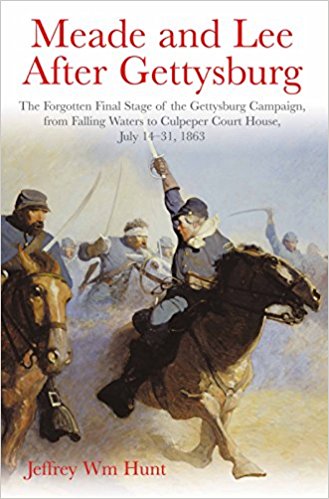Meade and Lee After Gettysburg: The Forgotten Final Stage of the Gettysburg Campaign from Falling Waters to Culpepper Court House, July 14-31, 1863 by Jeffrey Wm Hunt. Savas Beatie, 2017. Cloth, ISBN: 978-1611213430. $29.95.
 In the one hundred and fifty years following the Battle of Gettysburg, Civil War historians and enthusiasts have produced an unprecedented volume of scholarship on the war’s bloodiest battle. Over 6,000 books have been written on the three-day battle. Scholars have fed the public’s insatiable appetite for Gettysburg by writing scores of campaign studies and volumes on the individual days of fighting. Other Gettysburg topics range from compilations of human-interest stories, various map collections, regimental studies, and battlefield histories. Still, among the plethora of Gettysburg studies, some elements of the campaign remain understudied. Both academic and popular narratives close the Gettysburg Campaign with General Robert E. Lee’s move across the Potomac River, into Virginia. The weeks following the Army of Northern Virginia’s crossing of the Potomac River at Falling Waters, Maryland on the night of July 13, 1863, stand as one of the war’s understudied topics. Jeffrey Hunt, Director of the Texas Military Forces Museum, fills an important gap in the Gettysburg historiography. Meade and Lee After Gettysburg offers a narrative of the maneuvers and fighting between Lee’s army and General George Gordon Meade’s Army of the Potomac. In doing so, Hunt reveals the two weeks of campaigning as critical to the Gettysburg Campaign.
In the one hundred and fifty years following the Battle of Gettysburg, Civil War historians and enthusiasts have produced an unprecedented volume of scholarship on the war’s bloodiest battle. Over 6,000 books have been written on the three-day battle. Scholars have fed the public’s insatiable appetite for Gettysburg by writing scores of campaign studies and volumes on the individual days of fighting. Other Gettysburg topics range from compilations of human-interest stories, various map collections, regimental studies, and battlefield histories. Still, among the plethora of Gettysburg studies, some elements of the campaign remain understudied. Both academic and popular narratives close the Gettysburg Campaign with General Robert E. Lee’s move across the Potomac River, into Virginia. The weeks following the Army of Northern Virginia’s crossing of the Potomac River at Falling Waters, Maryland on the night of July 13, 1863, stand as one of the war’s understudied topics. Jeffrey Hunt, Director of the Texas Military Forces Museum, fills an important gap in the Gettysburg historiography. Meade and Lee After Gettysburg offers a narrative of the maneuvers and fighting between Lee’s army and General George Gordon Meade’s Army of the Potomac. In doing so, Hunt reveals the two weeks of campaigning as critical to the Gettysburg Campaign.
Hunt’s narrative begins where many Gettysburg campaign studies end, at Falling Waters. Here he argues that Meade should have pressed the Confederate forces, stating that “even a failed effort to destroy Lee would have left Meade in better graces with his superiors and the press than no effort at all” (21). On July 17, Federal infantry began moving across the Potomac River, into Virginia. As the Federal forces moved deeper into Loudoun Valley, Meade lamented the lack of reliable intelligence on Lee’s position. He remained fearful of a Confederate offensive and the enemy maneuvering between his army and Washington, D.C. These factors, combined with the weakened and tired status of the Union army, lead Meade to be cautious in his pursuit.
One of the most critical moments in the move to the Rappahannock occurred at Manassas Gap on July 23. Here, with elements of the Union cavalry holding the gap, the Army of the Potomac had an opportunity to capture Front Royal, Virginia, and isolate the Confederates within the northern part of the Shenandoah Valley. In order to capitalize on the opportunity at Manassas Gap, Meade needed to act quickly and to make-up for the thirty-five hours his army sat idle on July 21-22. He ordered the army’s Third Corps, commanded by General William French, to assail the gap. Here, approximately 600 Confederates held the mountains against a cautious and tentative Federal thrust. This action enabled the Confederates to maneuver their men through Manassas Gap toward Culpepper, Virginia, moving ever closer to the Rappahannock River. Once again, the Confederate army had eluded Meade. Hunt argues that Meade’s “innate caution hobbled the movements of the Army of the Potomac and allowed imagined fears to fatally influence its operations” (266).
Among the most useful insights from Hunt’s work is his evaluation of high command, and particularly the strategic decisions of Meade and Lee. On the whole, from July 14 to the 31, Hunt finds Meade’s leadership indecisive and cautious. Falling in line with convention, Hunt questions Meade’s inactivity at Williamsport, concluding, “Lee had never before been so vulnerable” (20). Moreover, Hunt perpetuates a popular canard that success at Williamsport would have ended the Civil War. “It is nearly impossible to argue,” he writes, “that the destruction of the Army of Northern Virginia would not have brought about the end of the war” (20). Meade proved victim to his “risk-adverse mind” (108). Lee, on the other hand, acted with decisiveness and clarity of strategic vision. Hunt concludes that the Confederate high command “clearly bested their opponents in the tactical, operational, and strategic sense” (268). These two weeks of maneuvering proved that Lee’s forces, while beaten at Gettysburg, were not demoralized or destroyed.
Hunt continues the narrative of events following the battle of Gettysburg in two forthcoming volumes, both to be published by Savas Beatie. The second volume, Meade and Lee at Bristoe Station, exploring the action between August 1 and October 31, 1863, is anticipated in fall 2018. While some of Hunt’s accompanying maps are uninspired, and his conclusions on the army commanders rather conventional, Meade and Lee After Gettysburg offers an important, welcomed addition to the Gettysburg scholarship.
Jennifer M. Murray is Assistant Professor of History at The University of Virginia’s College at Wise and author of On A Great Battlefield (2014).




